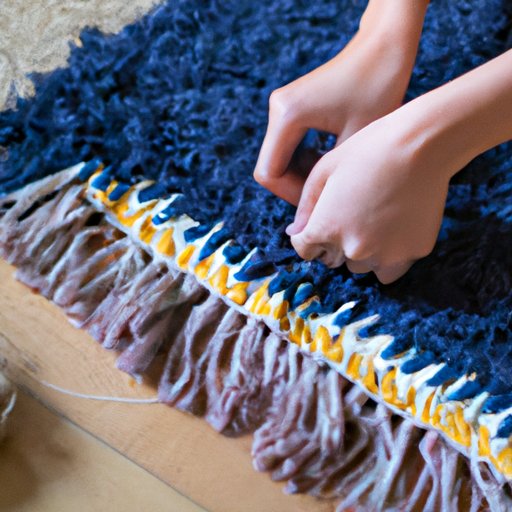
Introduction
Rugs can add warmth, texture, and style to any room, and making your own rug can be a fun and rewarding DIY project. Whether you are a seasoned crafter or just starting out, this article will provide you with practical tips and advice on how to make a rug from scratch.
Choosing the Type of Rug to Make
There are many different types of rugs, each with their own unique characteristics. Some popular types of rugs include hooked rugs, braided rugs, and woven rugs. Hooked rugs are made by pulling loops of yarn or fabric through a mesh or burlap backing. Braided rugs are made by braiding strips of fabric or yarn together and coiling them into a spiral. Woven rugs are made by interlacing threads on a loom.
If you are a beginner, a hooked rug may be the easiest type of rug to make. Braided rugs can also be relatively simple, although they require more time and patience. Woven rugs may be more challenging for beginners, but they often have a more intricate and professional-looking finish.
Gathering Materials and Tools
The materials and tools you need will depend on the type of rug you choose to make. For a hooked rug, you will need a rug hook tool, a mesh or burlap backing, and yarn or fabric strips. For a braided rug, you will need strips of fabric or yarn, a needle and thread, and a non-stick mat or table. For a woven rug, you will need a loom, yarn, and a shuttle.
You can purchase these materials and tools at craft stores, online retailers, or specialty rug-making stores. Look for high-quality materials and tools that will last, as the process of making a rug can be quite time-consuming.
Preparing Materials for Rug-Making
Once you have gathered your materials, you will need to prepare them for rug-making. Cut your fabric or yarn into strips that are the same width and length, depending on the type of rug you are making. If you are making a hooked rug, you will need to cut your strips slightly wider than the mesh or burlap backing. If you are making a braided rug, you will need to braid your fabric or yarn strips together tightly, using a needle and thread to stitch the end of each strip to the beginning of the next.
Starting the Rug
To start your rug, you will need to anchor your fabric or yarn to your backing material. If you are making a hooked rug, thread your yarn through the hook tool and push the hook through the mesh or burlap backing. Then, pull the yarn up through the hole and loop it back down through the backing, pulling the yarn taut. Continue this process, working in rows across the rug.
If you are making a braided rug, coil your braided strip into a spiral and secure the end with a needle and thread. Then, sew the spiral onto the non-stick mat or table, and continue coiling and sewing the spiral as it grows. For a woven rug, warp your loom with the yarn and use the shuttle to weave the weft in and out of the warp threads.
Continuing the Rug
As you continue making your rug, it is important to maintain consistency in size and tension. For a hooked rug, make sure your loops are the same depth and width throughout the rug. For a braided rug, make sure your braiding is tight and even. For a woven rug, make sure your warp threads are aligned, and your weft threads are evenly spaced.
Troubleshooting
Common problems that may occur when making a rug include knots coming undone, fabric fraying, or uneven tension. To fix these problems, make sure your knots are tight, and your fabric is secured to the backing. If your fabric is fraying, sew a zig-zag stitch along the edges to prevent further fraying. If your tension is uneven, try adjusting the tension on your loom or hook tool.
Finishing and Caring for the Rug
Once you have completed your rug, finish off the edges with a binding or a whip stitch. Then, vacuum or brush your rug regularly to keep it clean and free from dust and dirt. If your rug gets stained, spot clean it immediately with a mild detergent and water. Avoid using harsh chemicals or bleach on your rug, as this can damage the fibers.
Conclusion
Making a rug can be a fun and creative DIY project that can add a personal touch to your home décor. By following these practical tips and advice, you can create a rug that is not only beautiful but also functional and durable. So why not try making your own rug today?
Start your rug-making journey and create your own unique piece of home decor.




